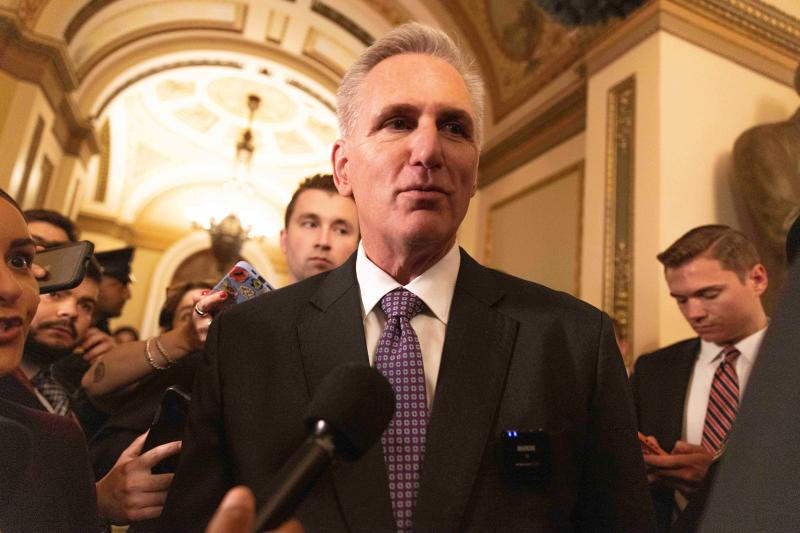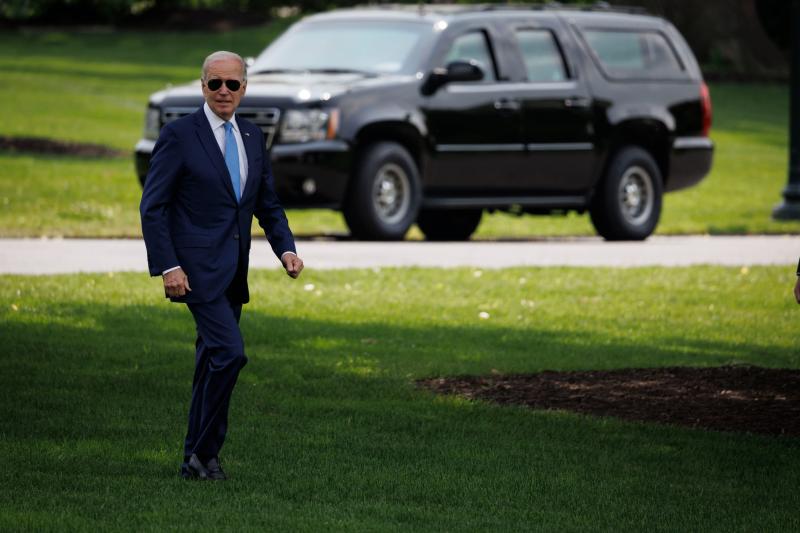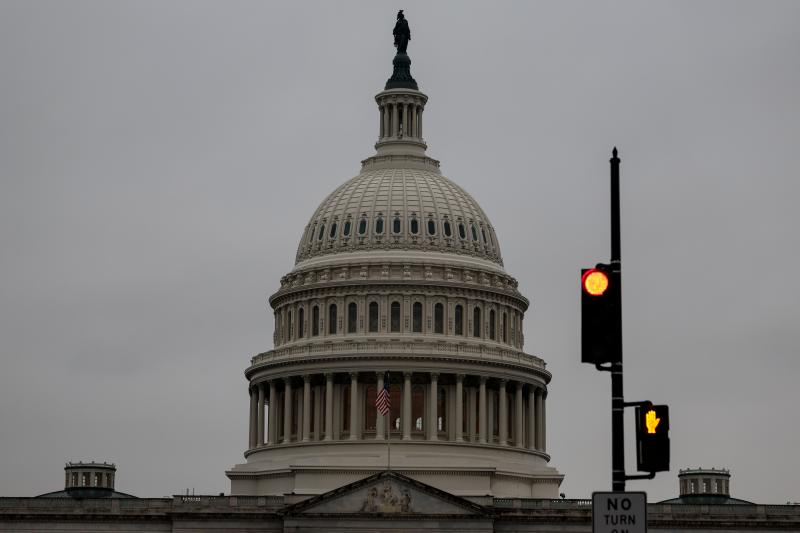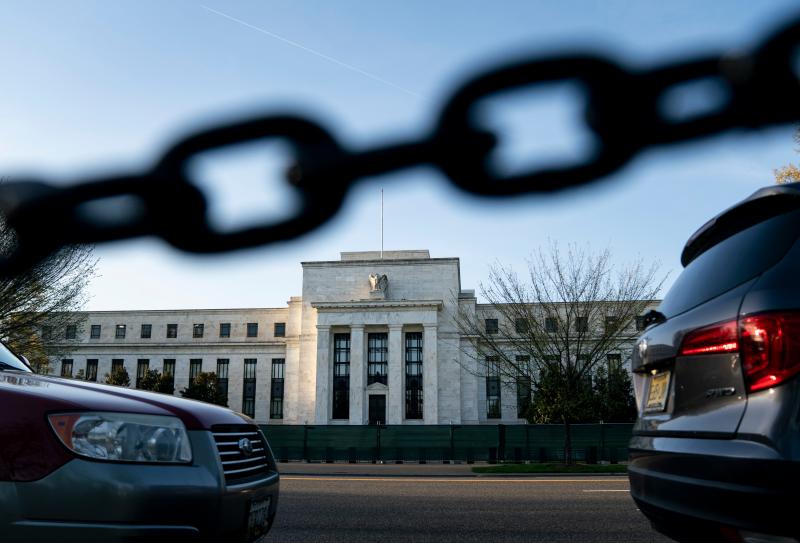Four Questions on the US Debt Crisis Observation | Xinhua News Agency | Crisis
Beijing, June 2 (Xinhua) - The United States Senate voted on the 1st to pass a bill on the federal government's debt ceiling and budget, which will take effect after being signed by President Biden.
Although this round of US debt ceiling crisis has temporarily eased, the outside world has increasingly questioned the origin, capital flow, sustainability and huge risks of the huge US debt. These issues are intertwined with issues such as US dollar hegemony, US party struggles, and US corruption, becoming a "gray rhinoceros" that threatens global economic and financial security.
In response to the four major concerns about the US debt crisis, which have been highly concerned by the outside world, Xinhua News Agency reporters have traced the root cause and clarified its origins.
On June 1, pedestrians walked past the "treasury bond Clock" in New York. The "treasury bond Clock" is a large counter, which updates the total public debt of the United States in real time and displays the amount that each American family has to bear.
Why does the United States repeatedly break through the upper limit and borrow recklessly when its assets are unable to repay its debts?
Since the end of World War II, the US Congress has adjusted the debt ceiling 103 times. According to data from the US Treasury Department, the size of the US federal debt has skyrocketed from $3.2 trillion in 1990 to over $31.4 trillion today, accounting for over 120% of the US gross domestic product.

GDP is an important indicator of a country's wealth, and if it is used as a measure of a country's solvency, the United States has become severely insolvent.
The so-called "debt ceiling" is the maximum amount of debt set by the United States Congress for the federal government to meet its payment obligations. Touching this "red line" means that the US Treasury Department's borrowing authorization has been exhausted. This mechanism was established in 1917 to regularly monitor government spending, but things have changed and it is now difficult to achieve the original intention of controlling debt growth. Instead, it has become a routine bargaining chip for the Democratic and Republican parties to compete for votes and seek personal gain.
In the past few decades, the US government has been accustomed to delaying crises by continuously pushing up fiscal deficits and easing monetary policy during economic downturns; In better economic years, they are enthusiastic about spending more money to seek political achievements in order to gain more votes, but lazy about promoting long-term structural reforms. This governance approach that pursues short-term benefits has raised debt to an unprecedented scale and turned the debt issue into a political game of beating drums and spreading flowers.
On May 31st, in Washington, D.C., the Republican Speaker of the House of Representatives, McCarthy, answered media questions.
The agreement reached by both parties on the debt ceiling issue this time is more moderate than the previous proposals they have fought for. This mutual compromise reflects one of the root causes of the US debt problem: under the system of two parties taking turns, both parties want to spend more money to win votes for political achievements. Although controlling debt growth is beneficial for the long-term development of the US economy, no government or political party is willing to carry the stigma of cutting benefits or raising taxes.
The New York Times said that the expanding debt of the United States has been caused by the joint efforts of both parties over the past few decades. The report estimates that since the beginning of this century, during the administrations of both Bush and Trump, both Republicans, debt has increased by $12.7 trillion; During the Democratic administrations of Obama and Biden, debt grew by $13 trillion.

In recent years, the struggle between the two parties has become increasingly intense, and debt ceiling negotiations are seen as a shining example of US election politics. Under this spotlight, the fundamental focus of lawmakers from both parties is not on the dangers of reckless borrowing, but even on a common understanding of ultimately raising the debt ceiling. The goal is to use the "extreme tug of war" in the final negotiations to force the other party to make more compromises and gain more political benefits for themselves.
This is the Treasury Building captured on January 20th in Washington, D.C., the capital of the United States.
What has the money borrowed from the United States been used for?
Excessive spending, lax discipline, and excessive spending are common terms used by observers when referring to the US government's fiscal policy.
The latest data released by the Congressional Budget Office in April 2023 showed that in the first half of fiscal year 2023, from October 2022 to March 2023, the US budget deficit reached $1.1 trillion, an increase of $430 billion year-on-year. The main reason for the widening deficit is an increase in government spending, with US government spending increasing by 13% year-on-year and revenue decreasing by 3% year-on-year in the first half of fiscal year 2023.
The long-term deficit in government finances is the result of the United States' habit of living beyond its budget and spending recklessly for nearly half a century, and it is also an important reason for the continuous accumulation and expansion of federal government debt. Under the influence of factors such as election politics and hegemonic policies, a large amount of financial resources in the United States have been severely wasted, used to satisfy the interests of interest groups and politicians. Not only has it aggressively expanded military spending to maintain hegemony, but it has also continued to spend money to please voters, seeking both "cannons" and "butter".

This is a photo of US President Biden taken on May 17th at the White House in Washington, D.C.
On the one hand, US defense spending is steadily increasing. According to a survey conducted by Statista Germany, US military spending has continued to rise since 2015, reaching $742 billion in 2021. In March of this year, the US government submitted a budget for the 2023 fiscal year, with the defense budget rising to $813.3 billion. It is expected that by 2032, this number may increase to $998 billion.
On the other hand, American politicians are constantly pushing for the government to introduce social welfare policies that lack sustainable fiscal support in order to win more votes. They are trying to please voters by throwing money out of pocket, but they are not seeking stable sources of income for these additional expenditures through fiscal reform. Instead, they are completely relying on continuing to borrow.
The National Public Radio reported that the major reasons for the sharp increase in the federal government's financial expenditure in recent years include: the war in Afghanistan and Iraq, the response to the COVID-19, the increase in medical expenses caused by the aging population, and the increase in other government social service expenditures. According to data from the "Cost of War" program at Brown University, the United States has invested over $4 trillion in wars in Afghanistan, Iraq, and Syria.
With high debt, debt interest alone has become a long-term financial burden for the US federal government. The latest data from the Congressional Budget Office shows that in the first half of fiscal year 2023, the US government's debt interest expenses alone increased by $90 billion year-on-year, a growth rate of 41%.
When the US Government Accountability Office released its annual National Financial Health Report in May this year, it clearly stated that the US federal government is facing unsustainable fiscal prospects. If policies are not adjusted, the debt scale will continue to accumulate at a rate that exceeds economic growth.

This is the Capitol building captured on January 19th in Washington, D.C., the capital of the United States.
Big and unable to collapse? Why hasn't the United States gone bankrupt due to long-term financial difficulties and excessive borrowing?
If a company were to borrow recklessly like the United States, it would have gone bankrupt long ago. The reason why the United States can continuously raise new debts to repay old debts ultimately lies in the hegemonic position of the US dollar in the international monetary system. It is the underlying logic that the United States seems to be "too big to fail" to master the printing power of international currency, threaten the world with US treasury bond, and control the global economic and financial lifeline.
As a dominant global reserve currency, the US dollar currently holds a share of nearly 60% in international reserves and nearly 40% in international payments. Relying on the hegemony of the US dollar, US treasury bond bonds have been able to dominate the global bond market and become the so-called "safe haven assets".
Economist Filippo Gori from the Organization for Economic Cooperation and Development recently published an article on the website of Foreign Affairs magazine titled "The Disaster of the US Debt Cap.". The article points out that most international trade is settled in US dollars, and the United States can print money to pay for purchasing goods from abroad. This way, even if a huge international trade deficit is formed, there is no need to worry about a shortage of funds.
Liu Jin, Director of the Investment Research Center at Changjiang Business School, said that as long as the US government borrows US dollar local currency bonds, theoretically it can repay the debt by printing money.

The United States maintains a long-term foreign trade deficit, exports US dollars and inflation, and forms a "debt cycle" system of US dollar recovery through a large amount of debt issuance. The extremely low borrowing costs have made the United States increasingly addicted to abusing hegemony and becoming addicted to borrowing.
"The widespread use of the US dollar in international transactions gives the United States an excessive privilege to trade and borrow in its own currency at preferential interest rates," Gori wrote.
This privilege allows the United States to hijack the interests of some sovereign countries and global investors. On the one hand, many people believe that if the United States controls the US dollar printing machine, theoretically there will never be a debt default; On the other hand, due to considerations of safety, liquidity, and profitability in trading activities, the outside world will not actively cut off from the US bond market and the US dollar system in the short term.
Australian economist Guo Shengxiang pointed out that it is this "too big to fail" monopoly advantage that has created the strange phenomenon of the United States being "insolvent" and not bankrupt. This is also the fundamental reason why the United States takes various measures to vigorously maintain the hegemony of the US dollar. However, this phenomenon that clearly goes against the laws and common sense of economics cannot last for long.
This is a photo of the White House taken on January 20th in the US capital, Washington.
What should the world do in the face of the continuous outflow of the US debt crisis, as it spreads globally?

For many years, relying on the US dollar's hegemonic debt system, the United States has continuously reaped and plundered the world, issuing excessive amounts of money, and shifting the blame of crises.
As an external symptom of the US debt crisis, the political farce of the debt ceiling is repeatedly unfolding in Washington, showcasing to the world how the terrible combination of US dollar hegemony and US party struggles can harm the world and expose the profound crisis of US dollar hegemony.
The website of the Lebanese "Square" TV station recently pointed out that the chaotic debt ceiling crisis of the United States cast a shadow on the so-called "risk-free" status of the US treasury bond, exposing the vulnerability of the US dollar as a reserve currency in the future.
With the massive oversupply of the US dollar, as well as the increasing harm of financial sanctions and long arm jurisdiction by the United States, the trend of diversification in the international monetary system is accelerating. The two parties in the United States have repeatedly conducted marginal explorations on the debt ceiling issue, disregarding global interests and continuously eroding the national credit of the United States endorsed by the US dollar.
The credit of the US dollar has suffered severe losses in the farce of the US debt ceiling. Gori pointed out that a severe debt ceiling crisis could accelerate the decline of US dollar hegemony, which would be a stunning defeat created by the United States itself.
This is the Federal Reserve Building captured on April 20, 2022 in Washington, D.C., USA.

In recent years, the United States has abused the hegemony of the US dollar, reaping the interests of various countries and weaponizing the international financial infrastructure, which has aroused more and more vigilance among countries. More and more countries are exploring the path of de dollarization by diversifying their currency reserves, establishing local currency settlement mechanisms, and strengthening international cooperation to break away from excessive dependence on the US dollar. The global trend of "de dollarization" is constantly strengthening.
According to data from the International Monetary Fund, as of the fourth quarter of 2022, the proportion of the US dollar in central bank foreign exchange reserves has dropped to 58.36%, the lowest level since data records began in 1995. The latest international capital flow report released by the US Treasury in March showed that at least 16 countries sold US treasury bond bonds in January this year. The seller list includes some close allies of the United States.
The arrangement of replacing the US dollar with other currencies in payment, settlement, and other fields is also gradually unfolding. Recently, Brazilian President Lula publicly called on BRICS countries to settle in their own currencies; India and Malaysia announced the settlement of trade in Indian rupees; ASEAN is discussing a shift towards using member country currencies for trade settlement. According to the Global Interbank Financial Communications Association, in January 2023, the US dollar accounted for approximately 40% of the global payment system, but has gradually declined in recent years.
After the escalation of the Ukraine crisis, Western countries such as the United States imposed multiple financial sanctions on Russia, including freezing Russia's foreign exchange reserves in developed country central banks and cutting off Russia's international business with commercial banks. These actions have raised global vigilance.
American political commentator Farid Zakaria pointed out that the United States cannot maintain world trust in the US dollar and is responsible for "de dollarization" on its own.
"Getting rid of the hegemony of the US dollar is not an easy goal to achieve, but this process has begun, and the momentum will become more and more obvious, with greater efforts," said Mahfi Eermez, an economist in Türkiye.

-END-
Visual: Su Liang




